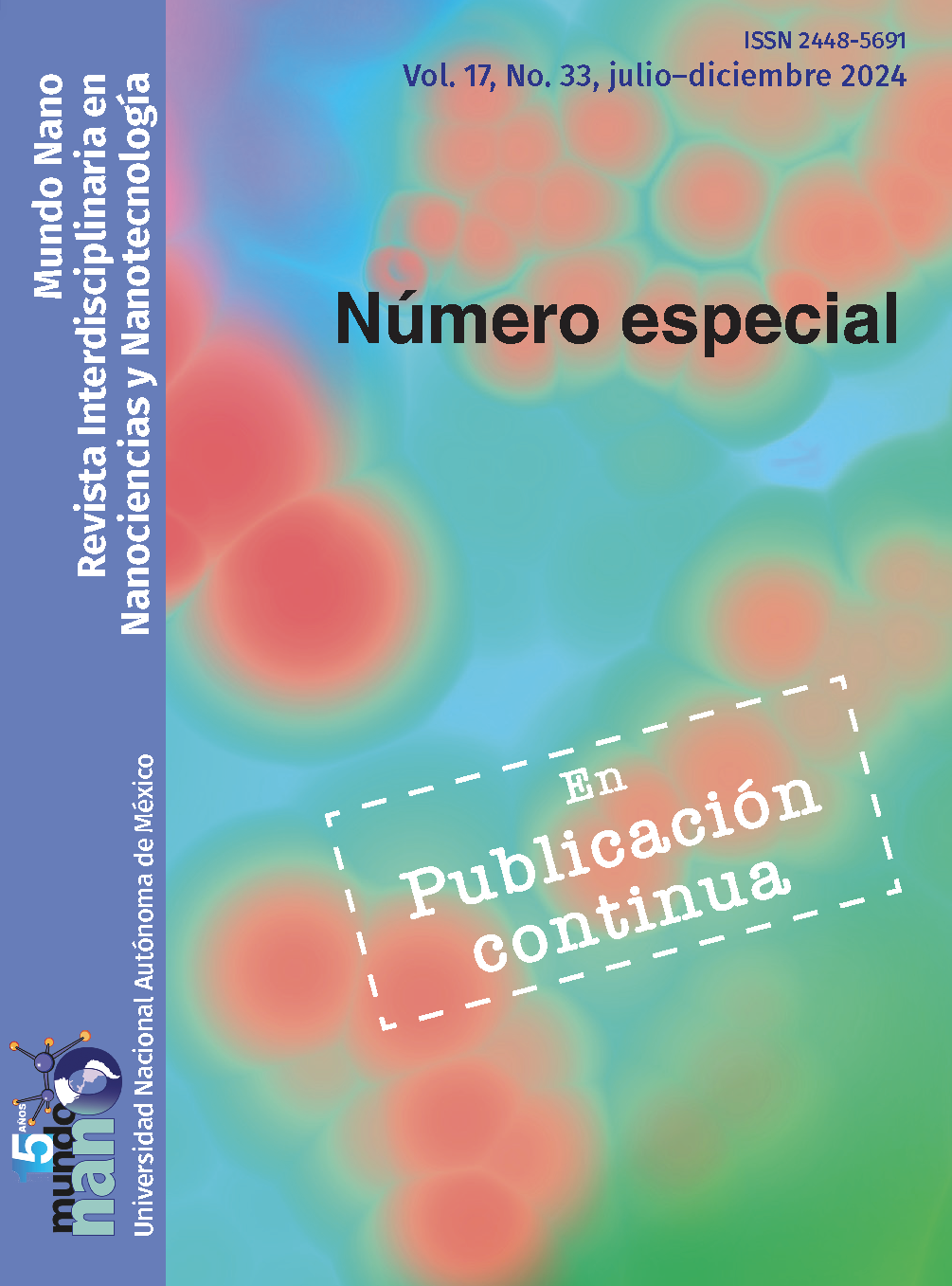Environmental safety of energy storing devices using carbon nanotubes: possible impacts of waste in aquatic and terrestrial environments
Contenido principal del artículo
Resumen
Electric double layer capacitors (EDLC) are energy storage devices based on the charging and discharging electrode-electrolyte interfaces of high surface area materials such as multi-walled carbon nanotubes (MWCNT) and activated carbon (AC). Despite the broad applicability, the final destination of these components is the environment, mainly water and soil, where they can represent impacts on organisms along different trophic levels. Bioassays with Raphidoceles subcapitata, are widely used to evaluate aquatic totoxicity and oligochaetes are good terrestrial bioindicators. The study aimed to evaluate aquatic and terrestrial toxicity of MWCNT from EDLC-type capacitors using bioindicators, R. subcapitata and Eisenia andrei. The MWCNT material was synthesized by the floating catalyst-based chemical vapor deposition method (FC-CVD) on stainless steel (AISI 304L). The MWCNT concentrations for the assays were 0.1 1.0, 10 and 100 mg.L–1 for the bioindicator R. subcapitata and the concentrations of 1, 10 and 100 mg.Kg–1 for bioindicator E. andrei. MWCNT inhibited the algal biomass in a concentration dependent manner at concentrations higher than 10 mg.L–1. In the soil the presence of MWCNT, at the concentrations tested did not cause mortality in the earthworm, but resulted in a significant mass reduction in the exposed organisms after 14 days. In the cytology analysis, it was not observed the production of micronuclei, but cytoplasmic vacuolization and nuclear atypia in coelomocytes were frequent. In the comet assay, there was a predominance of nucleoids in the stage 1 classification. Thus, no genotoxic effect was demonstrated in these organisms. The concentrations that showed toxic effects are within the range of environmentally expected concentrations. MWCNT are released from EDLC and may pose an occupational and environmental risk.
Descargas
Detalles del artículo

Mundo Nano. Revista Interdisciplinaria en Nanociencias y Nanotecnología, editada por la Universidad Nacional Autónoma de México, se distribuye bajo una Licencia Creative Commons Atribución-NoComercial 4.0 Internacional.
Basada en una obra en http://www.mundonano.unam.mx.
Citas
ABNT-NBR-15537. 2014. Ecotoxicologia terrestre – Toxicidade aguda – Método de ensaio com minhocas (Lumbricidae) – outubro.
Blaise, C., Gagne’, F. Ferard, J. F., Eullaffroy, P. (2008). Ecotoxicity of selected nano-materials to aquatic organisms. Environ Toxicol., 23(5): 591-8. https://doi.org/10.1002/20402. DOI: https://doi.org/10.1002/tox.20402
Braun, A, Sørensen, S. N., Rasmussen, R. F., Hartmann, N. B., Koch, C. B. (2008). Toxicity and bioaccumulation of xenobiotic organic compounds in the presence of aqueous suspensions of aggregates of nano-C(60). Aquat Toxicol., February 18, 86(3): 379-87. https://doi.org/10.1016/j.aquatox.2007.11.019. DOI: https://doi.org/10.1016/j.aquatox.2007.11.019
Boyes, W. K., Thornton, B. L. M., Al-Abed, S. R., Andersen, C. P., Bouchard, D. C., Burgess, R. M., Hubal, E. A. C., Kitchin, K., Reichman, J. R., Rogers, K. R., Ross, J. A., Rygiewicz, P. T., Scheckel, E. G., Thai, S. F., Zepp, R. G., Zucker, R. M. (2017). A comprehensive framework for evaluating the environmental health and safety implications of engineered nanomaterials. Crit Rev Toxicol, 49: 1-44. https://doi.org/10.1080/10408444.2017.1328400. DOI: https://doi.org/10.1080/10408444.2017.1328400
Bourdineaud, J. P., Štambuk, A., Šrut, M. et al. (2021). Gold and silver nanoparticles efects to the earthworm Eisenia fetida–the importance of tissue over soil concentrations. Drug Chem Toxicol, 44:12-29. https://doi.org/10.1080/01480545.2019.1567757. DOI: https://doi.org/10.1080/01480545.2019.1567757
Buzea, C., Bladino, I. I. P., Roobbie, K. Nanomaterials and nanoparticles: sources and toxicity. Biointerphases, 2(4): MR17 – MR71, 2007. https://doi.org/10.1116/1.2815690. DOI: https://doi.org/10.1116/1.2815690
CGEE – Centro de Gestão e Estudos Estratégicos. (2008). Energias do futuro. Relatório final. Brasília: Centro de Gestão e Estudos Estratégicos, 139 pp.
Carbonell, G., Pro, J., Gómez, N. et al. (2009). Sewage sludge applied to agricultural soil: ecotoxicological efects on representative soil. Ecotoxicol Environ Saf, 72: 1309-1319. https://doi.org/10.1016/j.ecoenv.2009.01.007. DOI: https://doi.org/10.1016/j.ecoenv.2009.01.007
Chen, M., Yin, J., Liang, Y., Yuan, S., Wang, F., Song, M., Wang, H. (2016). Oxidative stress and immunotoxicity induced by graphene oxide in zebrafish. Aquat. Toxicol., 174: 54-60. https://doi.org/10.1016/j.aquatox.2016.02.015. DOI: https://doi.org/10.1016/j.aquatox.2016.02.015
Chu, S., Majumdar, A. (2012). Opportunities and challenges for a sustainable energy future. Nature, 488. https://doi.org/10.1038/nature11475. DOI: https://doi.org/10.1038/nature11475
Cornelis, G., Hund-Rinke Kerstin, Nico, W., Van den Brink, A. J. Kuhlbusch. (2014). Fate and bioavailability of engineered nanoparticles in soils: a review. Critical Reviews in Environmental Science and Technology, 44: 2720-2764, 2014. https://doi.org/10.1080/10643389.2013.829767. DOI: https://doi.org/10.1080/10643389.2013.829767
Courtois, P., Rorat, A., Lemiere, S. et al. (2021). Medium-term efects of Ag supplied directly or via sewage sludge to an agricultural soil on Eisenia fetida earthworm and soil microbial communities. Chemosphere, 269: 128761. https://doi.org/10.1016/j.chemosphere.2020.128761. DOI: https://doi.org/10.1016/j.chemosphere.2020.128761
Dalton, A. B., Collins, S., Munoz, E., Razal, J. M., Ebron, V. H., Ferraris, J. P., Coleman, J. N., Kim, B. G., Baughman, R. H. Super-tough carbon nanotube fibres: these extraordinary composite fibers can be woven into electronic textiles. Nature, v. 423: 703, 2003. https://doi.org/10.1038/423703a. DOI: https://doi.org/10.1038/423703a
Dillon, A. C., Jones, K. M., Bekkedahl, T. A., Kiang, C. H., Bethune, D. S., Heben, M. J. (1997). Storage of hydrogen in single-walled carbon nanotubes. Nature, 386: 377-379, 1997. https://doi.org/10.1038/386377a0. DOI: https://doi.org/10.1038/386377a0
Du, C., Pan, N. (2006). Supercapacitors using carbon nanotubes films by electrophoretic deposition, J. Power Sources, 160: 1487-1494. https://doi.org/10.1016/jpowsour.2006.02.092. DOI: https://doi.org/10.1016/j.jpowsour.2006.02.092
Federici, G., Shawn, B., Handy, R. (2007). Toxicity of titanium dioxide nanoparticles to rainbow trout (Oncorhynchus mykiss): gill injury, oxidative stress, and other physiological effects. Aquat. Toxicol., 84: 415. https://doi.org/10.1016/j.aquatox.2007.07.009. DOI: https://doi.org/10.1016/j.aquatox.2007.07.009
Fernandes, I. F., Utsunomiya, H. S. M., Valverde, B. S. L., Ferraz, J. V. C., Fujiwara, G. H., Gutierrez, D. M., Oliveira, C., Belussi, L. F., Feernandes, M. N., Carvalho, C. S. (2021). Ecotoxicological evaluation of water from the Sorocaba River using na integrated analysis of biochemical and morphological biomarkers in bullfrog tadpoles, Lithobates catesbeianus (Shaw, 1802). Chemosphere, 275: 130000. https://doi.org/10.1016/j.chemosphere.2021.130000. DOI: https://doi.org/10.1016/j.chemosphere.2021.130000
Forbes, V. E., Agatz, A., Ashauer, R. et al. (2021). Mechanistic efect modeling of earthworms in the context of pesticide risk assessment: synthesis of the FORESEE Workshop. Integr Environ Assess Manag, 17: 352-363. https://doi.org/10.1002/ieam.4338. DOI: https://doi.org/10.1002/ieam.4338
Gall, A., Pascal, A. A., Robert, B. (2015). Vibrational techniques applied to photosynthesis: resonance Raman and fluorescence line-narrowing. Biochimica et Biophysica Acta – Bioenergetics, 1847(1): 12-18. https://doi.org/10.1016/j.bbabio.2014.09.009. DOI: https://doi.org/10.1016/j.bbabio.2014.09.009
Gomes, A. L. S., Balsamo, P. J., Sprogis, A., Ceragiolli, H. J., Silva, T. N., Oliveira, E. C., Cacuro, T. A., Irazusta, S. P. (2018). Avaliação de toxicidade de nanotubos de carbono de parede múltipla (MWCNT). Boletim Técnico da Faculdade de Tecnologia de São Paulo., 45: 16-22.
Gottschalk, F., Sonderer, T., Scholz, R.W., Nowack, B. (2009). Modeled environmental concentrations of engineered nanomaterials (TiO2, ZnO, Ag, CNT, fullerenes) for different regions. Environ. Sci. Technol. 43: 9216-9222. https://doi.org/10.1021/es9015553. DOI: https://doi.org/10.1021/es9015553
Gu, X., Liu, Z., Wang, X. et al. (2017). Coupling biological assays with difusive gradients in thin-flms technique to study the biological responses of Eisenia fetida to cadmium in soil. J Hazard Mater, 339: 340-346. https://doi.org/10.1016/j.jhazmat.2017.06.049. DOI: https://doi.org/10.1016/j.jhazmat.2017.06.049
Hou,Y, Li, P., Zhou, H., Zhu, X., Chen, H., Lee, J. et al. (2015). Evaluation of β-amyloid peptides fibrillation induced by nanomaterials based on molecular dynamics and surface plasmon resonance. Nanoscience & Nanotechnology, 15: 1110-6. https://doi.org/10.1166/jnn.2015.9069. DOI: https://doi.org/10.1166/jnn.2015.9069
Hu, X., Ouyang, S., Mu, L., An, J., Zhou, O. Effects of graphene oxide and oxidized carbon nanotubes on the cellular division, microstructure, uptake, oxidative stress and metabolic profiles. Environ. Sci. Technol, 21: 1-28. https://doi.org/10.1021/acs.est.5b02102. DOI: https://doi.org/10.1021/acs.est.5b02102
Hu, L., Choi, J. W., Yang, Y., Jeong, S., La Mantia, F., Cui, L-F., Cui, Y. (2009). Highly conductive paper for energy-storage devices. Proc. Natl. Acad. Sci., 106: 21490-21494, 2009. https://doi.org/10.1073/pnas.0908858106. DOI: https://doi.org/10.1073/pnas.0908858106
Irazusta, S. P., Ferreira, M. S., Balsamo, P. J., Almeida, L. S., Ceragiolli, H. J. (2021). Toxicity and possibly reduced graphene oxide cellular interaction with Raphidoceles subcapitata: ultrastructural analysis. Research, Society and Development, 10(15): e459101520377. https://doi.org/10.33448/rsd-v10i15.20377. DOI: https://doi.org/10.33448/rsd-v10i15.20377
Irazusta, S. P, Oliveira, E. C., Ceragioli, H. J., Souza, B. F. S, Mendonça, M. C. P., Soares, E. S., Azevedo J. R., Cruz- Höfling, M. A., Cruz, Z. M. A. (2018). Stress oxidativo e alterações enzimáticas induzidas por nanotubos de carbono de paredes múltiplas (MWCNT) funcionalizados com polietileno glicol no tecido hepático de camundongos. Revinter, 11(1): 05-25. https://doi.org/10.22280/revintervol11ed1.366. DOI: https://doi.org/10.22280/revintervol11ed1.366
Johnston, H. J., Hutchison, G. R., Christensen, F. M., Peters, S., Hankin, S., Aschberger, K., Stone, V. (2010). A critical review of the biological mechanisms underlying the in vivo and in vitro toxicity of carbono nanotubes: The contribution of physico-chemical characteristics. Nanotoxicology, 4(2): 207-246. https://doi.org/10.3109/17435390903569639. DOI: https://doi.org/10.3109/17435390903569639
Kahru, A., Dubourguier, H. C. (2010). From ecotoxicology to nanoecotoxicology. Toxicology, 269: 105-19. https://doi.org/10.1016/j.tox.2009.08.016. DOI: https://doi.org/10.1016/j.tox.2009.08.016
Keller, A. A., McFerran, S., Lazareva, A., Suh, S. (2013). Global life cycle releases of engineered nanomaterials. J. Nanopart. Res., 15(6): 1-17. https://doi.org/10.1007/s11051-013-1692-4. DOI: https://doi.org/10.1007/s11051-013-1692-4
Kim, G. M., Nam, I. W., Yang, B., Yoon, H. N., Lee, H. K., Park, S. (2019). Carbon nanotube (CNT) incorporated cementitious composites for functional construction materials: the state of the art. Composite Structures, 227(1). https://doi.org/10.1016/j.compstruct.2019.111244. DOI: https://doi.org/10.1016/j.compstruct.2019.111244
Köktürk, M., Altindag, F., Nas, M., Calimli, M. H. (2021). Ecotoxicological efects of bimetallic PdNi/MWCNT and PdCu/MWCNT nanoparticles onto DNA damage and oxidative stress in earthworms. Biological Trace Element Research, July 27. https://doi.org/10.1007/s12011-021-02821-z. DOI: https://doi.org/10.1007/s12011-021-02821-z
Kwok, K. W., Leung, K. M., Flahaut, E., Cheng, J., Cheng, S. H. (2010). Chronic toxicity of double-walled carbon nanotubes to three marine organisms: influence of different dispersion methods. Nanomedicine, 5(6): 951-961, 2010. https://doi.org/10.2217/nnm.10.59. DOI: https://doi.org/10.2217/nnm.10.59
Li, S., Irin, F., Atore, F. O. et al. (2013). Determination of multi-walled carbon nanotube bioaccumulation in earthworms measured by a microwave-based detection technique. Sci Total Environ, 445-446: 9-13. https://doi.org/10.1016/j.scitotenv.2012.12.037. DOI: https://doi.org/10.1016/j.scitotenv.2012.12.037
Lobo, A. O., Ramos, S. C., Antunes, E. F., Marciano, F. R., Trava-Airoldi, V. J., Corat, E. J. (2012). Fast functionalization of vertically aligned multi-walled carbon nanotubes using oxygen plasma. Materials Letters, 70: 89-93. https://doi.org/10.1016/j.matlet.2011.11.071. DOI: https://doi.org/10.1016/j.matlet.2011.11.071
Long, Z. F., Ji, J., Yang, K., Lin, D. H., Wu, F. C. (2012). Systematic and quantitative investigation of the mechanism of carbon nanotubes’ toxicity toward algae. Environ. Sci. Technol., 46: 8458-8466. https://doi.org/10.1021/es301802g. DOI: https://doi.org/10.1021/es301802g
Lovern, S. B., Stricler, J. R., Klaper, R. (2007). Behavioral and physiological changes in Daphnia magna when exposed to nanoparticle suspensions (titanium dioxide, nano-C60, and C60HxC70Hx). Environ. Sci. Technol., 41: 4465-72. https://doi.org/10.1021/es062146p. DOI: https://doi.org/10.1021/es062146p
Lu, M. (2013). Supercapacitors: materials, systems and applications. New York: Wiley, 236.
Lu, T., Zhang, Q., Zhang, Z., Hu, B., Chen, J., Qian, J. C. H. (2021). Pollutant toxicology with respect to microalgae and cyanobacteria. Journal of Environmental Sciences, 99: 175-186. https://doi.org/10.1016/j.jes.2020.06.033. DOI: https://doi.org/10.1016/j.jes.2020.06.033
Magdolenova, Z. et al. (2014). Mechanisms of genotoxicity. A review of in vitro and in vivo studies with engineered nanoparticles. Nanotoxicology, 8(3): 233-278. https://doi.org/10.3109/17435390.2013.773464. DOI: https://doi.org/10.3109/17435390.2013.773464
Mahapatra, I. et al. (2015). Probabilistic modelling of prospective environmental concentrations of gold nanoparticles from medical applications as a basis for risk assessment. Journal of Nanobiotechnology, 13: 1-14. https://doi.org/10.1186/s12951-015-0150-0. DOI: https://doi.org/10.1186/s12951-015-0150-0
Mauter, M. S., Elimelech, M. (2008). Environmental applications of carbon-based nanomaterials. Environ. Sci. Technol., 42: 5843-5859. https://doi.org/10.1021/es8006904. DOI: https://doi.org/10.1021/es8006904
Mitrano, D. M., Motellier, S., Clavaguera, S., Nowack, B. (2015). Review of nanomaterial aging and transformations through the life cycle of nano-enhanced products. Environ Int., 77: 132-147. https://doi.org/10.1016/j.envint.2015.01.013. DOI: https://doi.org/10.1016/j.envint.2015.01.013
Neal, A. L. (2008). What can be inferred from bacterium–nanoparticle interactions about the potential consequences of environmental exposure to nanoparticles? Ecotoxicology, 17: 362- 371. https://doi.org/10.1007/s10646-008-0217-x. DOI: https://doi.org/10.1007/s10646-008-0217-x
Nogueira, P. F. M., Nakabayashi, D., Zucolotto, V. (2015). The effects of graphene oxide on green algae Raphidocelis subcapitata. Aquatic Toxicology, 166: 29-35. https://doi.org/10.1016/j.aquatox.2015.07.001. DOI: https://doi.org/10.1016/j.aquatox.2015.07.001
Nowack, B., James F. Ranville, Stephen Diamond, Julian A. Gallego-Urrea, Chris Metcalfe, Jerome Rose, Nina Horne, Albert A. Koelmans, Stephen J. Klaine. (2012). Potential scenarios for nanomaterial release and subsequent alteration in the environment. Environmental Toxicology and Chemistry, 31(1): 50-59. https://doi.org/10.1002/etc.726. DOI: https://doi.org/10.1002/etc.726
Oberdörster, G., Oberdörster, E., Oberdörster, J. (2005). Nanotoxicology: an emerging discipline evolving from studies of ultrafine particles. Environ Health Perspect., July, 113(7): 823-39, 2005. https://doi.org/10.1289/ehp.7339. DOI: https://doi.org/10.1289/ehp.7339
Pakarinen, K., Petersen, E. J., Alvila, L., Waissi-leinonen, G. C., Akkanen, J., Leppänen, M. T., Kukkonen, J. V. K. (2013). A screening study on the fate of fullerenes (nC60) and their toxic implications in natural freshwaters. Environ. Toxicol. Chem. 32: 1224-1232, 2013. https://doi.org/10.1002/etc.2175. DOI: https://doi.org/10.1002/etc.2175
Parab, N. D. T., Tomar, V. (2012). Raman spectroscopy of algae: a review. Journal of Nanomedicine and Nanotechnology, 3(2). https://doi.org/10.4172/2157-7439.1000131. DOI: https://doi.org/10.4172/2157-7439.1000131
Paschoalino, M. P., Marcone, G. P. S., Jardim, W. F. (2010). Os nanomateriais e a questão ambiental. Quím. Nova. 33b(2): 421-430. https://doi.org/10.1590/s0100-40422010000200033. DOI: https://doi.org/10.1590/S0100-40422010000200033
Patel, A., Tiwari, S., Parihar, P., Singh, R., Prasad, S. M. (2019). Carbon nanotubes as plant growth regulators: impacts on growth, reproductive system, and soil microbial community. In Tripathi, D. K., Ahmad, P., Sharma, S., Chauhan, D. K., Dubey, N. K. (eds.). Nanomaterials in plants, algae and microorganisms. Cambridge: Academic Press, 23–42. https://doi.org/10.1016/b978-0-12-811488-9.00002-0. DOI: https://doi.org/10.1016/B978-0-12-811488-9.00002-0
Petersen, E. J., Huang, Q., Weber, W. J. (2010). Relevance of octanol water distribution measurements to the potential ecological uptake of multi-walled carbon nanotubes. Environ Toxicol Chem., 29: 1106-1112. https://doi.org/10.1002/etc.149. DOI: https://doi.org/10.1002/etc.149
Petersen, E. J., Henry, E. B. (2012). Methodological considerations for testing the ecotoxicity of carbon nanotubes and fullerenes: review. Environ. Toxicol. and Chem., 31(1): 60-72.
Ramrakhiani, M. (2012). Nanostructures and their applications. Recent Research in Science and Technology, 4(8): 14-19, 2012. https://doi.org/10.1002/etc.710. DOI: https://doi.org/10.1002/etc.710
Reynolds, A., Giltrap, D. M., Chambers, P. G. (2021). Acute growth inhibition & toxicity analysis of nano-polystyrene spheres on Raphidocelis subcapitata. Ecotoxicology and Environmental Safety, 207(April): 111153. https://doi.org/10.1016/j.ecoenv.2020.111153. DOI: https://doi.org/10.1016/j.ecoenv.2020.111153
Ren, W., Ren, G., Teng, Y., Li, Z., Li, L. (2015). Time-dependent effect of graphene on the structure, abundance, and function of the soil bacterial community. J. Hazard Mater., 297: 286-294. https://doi.org/10.1016/j.jhazmat.2015.05.017. DOI: https://doi.org/10.1016/j.jhazmat.2015.05.017
Saxena, F. P., Sangela, V., Ranjan, S., Dutta, V., Dasgupta, N., Phulwaria, M., Rathore, D. S. (2020). Aquatic nanotoxicology: impact of carbon nanomaterials on algal. Energ. Ecol. Environ., 5: 240-252. https://doi.org/10.1007/s40974-020-00151-9. DOI: https://doi.org/10.1007/s40974-020-00151-9
Schwab, F., Bucheli, T. D., Lukhele, L. P., Magrez, A., Nowack, B., Sigg, L., Knauer, K. (2011). Are carbono nanotube effects on green algae caused by shading and agglomeration? Environ. Sci. Technol., 45: 6136-6144. https://doi.org/10.1021/es200506b. DOI: https://doi.org/10.1021/es200506b
Singh, N. P. et al. (1988). A simple technique for quantitation of low levels of DNA damage in individual cells. Exp. Cell. Res, 175: 184-91. https://doi.org/10.1016/0014-4827(88)90265-0. DOI: https://doi.org/10.1016/0014-4827(88)90265-0
Snow, E. S., Perkins, F. K., Houser, E. J., Badescu, S. C., Reinecke, T. L. (2005). Chemical detection with a single-walled carbon nanotube capacitor. Science, 307: 1942-1945. https://doi.org/10.1126/science.1109128. DOI: https://doi.org/10.1126/science.1109128
Sohn, E. K., Chung, Y. S ., Johari, S. A., Kim, T. G., Kim, J. K., Lee, J. H., Lee, Y. H., Kang, S. W., Yu, J. (2015). Acute toxicity comparison of single-walled carbon nanotubes in various freshwater organisms. BioMed Research International, article ID 323090, 7. https://doi.org/10.1155/2015/323090. DOI: https://doi.org/10.1155/2015/323090
Sun, W., Meng Z., Li R. et al. (2020). Joint efects of microplastic and dufulin on bioaccumulation, oxidative stress and metabolic profle of the earthworm (Eisenia fetida). Chemosphere, 263: 128171. https://doi.org/10.1016/j.chemosphere.2020.128171. DOI: https://doi.org/10.1016/j.chemosphere.2020.128171
Tong, Z., Bischoff, M., Nies, L., Applegate, B., Turco, R. F. (2007). Impact of fullerene (C60) on a soil microbial community. Environ. Sci. Technol., 41: 2985-92. https://doi.org/10.1021/es061953l. DOI: https://doi.org/10.1021/es061953l
Tourinho, P. S. et al. (2012). Metal based nanoparticles in soil: fate, behavior, and effects on soil invertebrates. Environmental Toxicology and Chemistry, 31(8): 1679-1692. https://doi.org/10.1002/etc.1880. DOI: https://doi.org/10.1002/etc.1880
Unrine, J. M., Tsyusko, O. V., Hunyadi, S. E. et al. (2010). Efects of particle size on chemical speciation and bioavailability of copper to earthworms (Eisenia fetida) exposed to copper nanoparticles. J. Environ Qual., 39: 1942-1953. https://doi.org/10.2134/jeq2009.0387. DOI: https://doi.org/10.2134/jeq2009.0387
Valant, J., Drobne, D., Novak, S. (2012). Effect of ingested titanium dioxide nanoparticles on the digestive gland cell membrane of terrestrial isopods. Chemosphere, 87(1): 19-25. https://doi.org/10.1016/j.chemosphere.2011.11.047. DOI: https://doi.org/10.1016/j.chemosphere.2011.11.047
Van der Zande, M., Junker, R., Walboomers, X. F., Jansen, J. A. (2010). Carbon nanotubes in animal models: a systematic review on toxic potential. Tissue Eng., Part B, 17(1): 57-69. https://doi.org/10.1089/tem.TEB.2010.0472. DOI: https://doi.org/10.1089/ten.teb.2010.0472
Vicentini, R., Costa, H. L., Nunes, W., Vilas Boas, O., Soares, D. M., Alves, T. A., Real, C., Bueno, C., Peterlevitz, A. C., Zanin. H. (2018). Direct growth of mesoporous carbon on aluminum foil for supercapacitors devices. Journal of Materials Science: Materials in Electronics, 29(6): 1-10. https://doi.org/10.1007/s10854-018-9121-1. DOI: https://doi.org/10.1007/s10854-018-9121-1
Vicentini, R., Nunes, W. G., Costa, L. H., Da Silva, L. M., Pascona, A., Jackson, P., Doubekc, G., Zanin, H. (2019). Highly stable nickel-aluminum alloy current collectors and highly defective multi-walled carbon nanotubes active material for neutral aqueous-based electrochemical capacitors. Journal of Energy Storage, 23: 116-127. https://doi.org/10.1016/j.est.2019.01.013. DOI: https://doi.org/10.1016/j.est.2019.01.013
Waissi, G. C., Bold, S., Pakarinen, K., Akkanen, J., Leppanen, M. T., Petersen, E. J., J. V. K. Kukkonen. (2017). Chironomus riparius exposure to fullerene-contaminated sediment results in oxidative stress and may impact life cycle parameters. J. Hazard Mater, January, 15(322)(Pt A): 301-309. https://doi.org/10.1016/jhazmat.2016.04.015. DOI: https://doi.org/10.1016/j.jhazmat.2016.04.015
Wick, P., Manser, P., Limbach, L. K., Dettlaff-Weglikowska, U., Krumeich, F., Roth, S., et al. (2007). The degree and kind of agglomeration affect carbon nanotube cytotoxicity. Toxicology Letters., 168: 121-131. https://doi.org/10.1016/j.toxlet.2006.08.019. DOI: https://doi.org/10.1016/j.toxlet.2006.08.019
Wang, H., Shao, B., Yu, H. et al. (2019). Neuroprotective role of hyperforin on aluminum maltolate-induced oxidative damage and apoptosis in PC12 cells and SH-SY5Y cells. Chem Biol Interact, 299: 15-26. https://doi.org/10.1016/j.cbi.2018.11.016. DOI: https://doi.org/10.1016/j.cbi.2018.11.016
Xiao, L., Li, M., Hu, J., Dai, J. et al. (2020). Assessment of earthworm activity on Cu, Cd, Pb and Zn bioavailability in contaminated soils using biota to soil accumulation factor and DTPA extraction. Ecotoxicol Environ Saf, 195: 110513. https://doi.org/10.1016/j.ecoenv.2020.110513. DOI: https://doi.org/10.1016/j.ecoenv.2020.110513
Zhang, B.T., Zheng, X., Li, H. F., Lin, J. M. (2013). Application of carbon-based nanomaterials in sample preparation: a review. Anal. Chim. Acta, 784: 1-17. https://doi.org/10.1016/j.aca.2013.03.05410. DOI: https://doi.org/10.1016/j.aca.2013.03.054
Zhang, L., Lei, C., Chen, J., Yang, Kun, Zhu, L., Lin, D. (2015). Effect of natural and synthetic surface coatings on the toxicity of multi-walled carbon nanotubes toward green algae. Carbon, 83: 198-207. https://doi.org/10.1016/j.carbon.2014.11.050. DOI: https://doi.org/10.1016/j.carbon.2014.11.050
Zhang, M., Wang, H., Song, Y., Huang, H., Shao, M., Liu, Y., Kang, Z. (2018). Pristine carbon dots boost the growth of Chlorella vulgaris by enhancing photosynthesis. ACS Appl Bio Mater, 1(3): 894-902. https://doi.org/10.1021/acsabm.8b00319. DOI: https://doi.org/10.1021/acsabm.8b00319
Zhang, C., Chen, X., Tan, L., Wang, J. (2018). Combined toxicities of copper nanoparticles with carbon nanotubes on marine microalgae Skeletonema costatum. Environ Sci Pollut Res, 25(13): 13127-13133. https://doi.org/10.1007/s11356-018-1580-7. DOI: https://doi.org/10.1007/s11356-018-1580-7
Zhao, C-M., Wang, W-X. (2010). Biokinetic uptake and efflux of silver nanoparticles in daphnia magna. Environ. Sci. Technol., 44: 7699-7704. https://doi.org/10.1021/es101484s. DOI: https://doi.org/10.1021/es101484s
Zhao, X. C., Liu, R. T. (2012). Recent progress and perspectives on the toxicity of carbon nanotubes at organism, organ, cell, and biomacromolecule levels. Environ. Int., 40: 244-255. DOI: https://doi.org/10.1016/j.envint.2011.12.003
Zhao, Y., Liu, Y., Zhang, X, Liao, W. (2021). Environmental transformation of graphene oxide in the aquatic environment. Chemosphere, e(262): 127885. https://doi.org/10.1016/j.envint.2011.12.003. DOI: https://doi.org/10.1016/j.chemosphere.2020.127885





